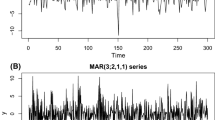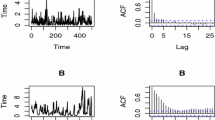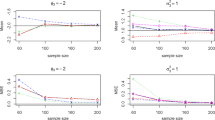Abstract
This study proposes the mixture Markov-switching autoregressive model, which allows variation in error distribution across different regimes. This model is generalized from the ordinary MS-AR model owing to two considerations, but related to each other. First, we have concern about the mixture of distributions or populations, which often prevails in economic time series. Second, when using the MS models to analyse economic fluctuation, we doubt if each regime in the model can have distinct distribution. All of these concerns are addressed by an empirical study.
Access this chapter
Tax calculation will be finalised at checkout
Purchases are for personal use only
Similar content being viewed by others
References
Ardia, D., Bluteau, K., Boudt, K., Catania, L., Peterson, B., Trottier, D.A.: Markov-Switching GARCH Models in R: The MSGARCH Package (2016)
Deschamps, P.J.: A flexible prior distribution for Markov switching autoregressions with Student-t errors. J. Econom. 133(1), 153–190 (2006)
Haas, M., Mittnik, S., Paolella, M.S.: A new approach to Markov-switching GARCH models. J. Financ. Econom. 2(4), 493–530 (2004)
Haas, M.: Skew-normal mixture and Markov-switching GARCH processes. Stud. Non-linear Dyn. Econom. 14(4), 1–56 (2010)
Hamilton, J.D.: A new approach to the economic analysis of nonstationary time series and the business cycle. Econometrica J. Econom. Soc. 57, 357–384 (1989)
Kole, E.: Regime switching models: an example for a stock market index. Econometric Institute, Erasmus School of Economics, Erasmus University Rotterdam, April 2010, Unpublished manuscript
Maneejuk, P., Pastpipatkul, P., Sriboonchitta, S.: Economic growth and business cycle: the case of Thailand. Int. J. Econ. Res. 14(6), 263–274 (2017)
Perlin, M.: MS-Regress-the MATLAB package for Markov regime switching models (2015)
Acknowledgement
We are grateful for financial support from Puay Ungpakorn Centre of Excellence in Econometrics, Faculty of Economics, Chiang Mai University.
Author information
Authors and Affiliations
Corresponding author
Editor information
Editors and Affiliations
Rights and permissions
Copyright information
© 2018 Springer International Publishing AG, part of Springer Nature
About this paper
Cite this paper
Maneejuk, P., Yamaka, W., Sriboonchitta, S. (2018). A Markov-Switching Model with Mixture Distribution Regimes. In: Huynh, VN., Inuiguchi, M., Tran, D., Denoeux, T. (eds) Integrated Uncertainty in Knowledge Modelling and Decision Making. IUKM 2018. Lecture Notes in Computer Science(), vol 10758. Springer, Cham. https://doi.org/10.1007/978-3-319-75429-1_26
Download citation
DOI: https://doi.org/10.1007/978-3-319-75429-1_26
Published:
Publisher Name: Springer, Cham
Print ISBN: 978-3-319-75428-4
Online ISBN: 978-3-319-75429-1
eBook Packages: Computer ScienceComputer Science (R0)




